WAP staff wishes all Antarcticians a Happy Easter celebration, with the hope that Holy Easter brings PEACE to the world


W.A.P. Worldwide Antarctic Program
WAP staff wishes all Antarcticians a Happy Easter celebration, with the hope that Holy Easter brings PEACE to the world

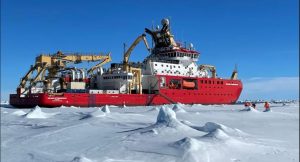 Climate researchers on board the RRS Sir David Attenborough have described their latest polar expedition as “really successful”.
Climate researchers on board the RRS Sir David Attenborough have described their latest polar expedition as “really successful”.
A team of 40 scientists, led by the University of East Anglia (UEA), have spent the last month conducting research in the Antarctic.
They have been investigating how carbon dioxide moves and transforms from the atmosphere into the Southern Ocean in the hope of improving models that make predictions about climate change.
Some of the work, such as operating underwater gliders, has been carried out remotely, almost 9,000 miles (14,500 km) at the UEA’s campus in Norwich.
Prof Karen Heywood, the UEA’s lead principal investigator, said her team had used “every scientific capability the ship had”. “We’ve been deploying instruments from the ship to profile the ocean, we’ve been collecting lots of water for analysing and we’ve been looking at how much krill there is,” she said.
Read more at: UEA scientists say latest polar research expedition ‘successful’ (bbc.com)
Thanks and credit to BBC
March 30, 1927 is an historical date,  when the sounds of the Morse alphabet were heard for the first time in Antarctica; fundamental step in the development of communications at those latitudes, That day at the Meteorological Observatory of the South Orkney Islands, the Orkney Station (LRT) was officially inaugurated.
when the sounds of the Morse alphabet were heard for the first time in Antarctica; fundamental step in the development of communications at those latitudes, That day at the Meteorological Observatory of the South Orkney Islands, the Orkney Station (LRT) was officially inaugurated.
The Argentine Navy radio officer Emilio Baldoni first established contact from Antarctica with the LIK station in Ushuaia, the southernmost city in the world and through it, with Buenos Aires.
In the eleven nights preceding this event, from Laurie Island, where the Orcadas Base is located, the head of the expedition José Manuel Moneta, together with Miguel Ángel Jaramillo, Pedro Martín Casariego, Luis Falico and Conrado Becker, encouraged the radio operator Emilio Baldoni , who, pushing the key with his firm fist, repeatedly broadcast into the ether: “CQ… CQ…CQ… de LRT… LRT… LRT… Orcadas, Orcadas, Orcadas” , which in clear text, means “General call from South Orkney Islands… from Orkney Islands…”, followed by the text: “Answer very long calls to tune in… calling from South Orkney Islands….”
 When on that historic day, March 30, 1927, the Morse sounds of the letters were heard and repeated at rhythmic intervals: “LRT… LRT…”, everyone shouted in unison “We… We… Finally …Finally…”, the question was: Who is calling us? and immediately you could hear “LRT… LRT… de LIK… LIK… LIK…”; exclaiming all together “They’re calling us from Ushuaia.”
When on that historic day, March 30, 1927, the Morse sounds of the letters were heard and repeated at rhythmic intervals: “LRT… LRT…”, everyone shouted in unison “We… We… Finally …Finally…”, the question was: Who is calling us? and immediately you could hear “LRT… LRT… de LIK… LIK… LIK…”; exclaiming all together “They’re calling us from Ushuaia.”
Well, the rest of the extraordinary event, is history!
To celebrate the historical event, next March 30th from 00,00 UTC through March 31st at 23:59 (UTC international time) LU2CN, SERVICIO AUXILIAR DE RADIOAFICIONADOS DE LA ARMADA S.A.R.A. will carry out a CW activity to recall this historic event for Argentina.
.
A special certificate is available and will be issued for free to those who can make a contact.
WAP and Hams WW will be on air, for sure… we just hope the LUs operator can pay attention also to the Hams outside South America!
TNX: | SARA | QSL 97 años del primer enlace radiotelegráfico con la Antártida – QSLOG.AR
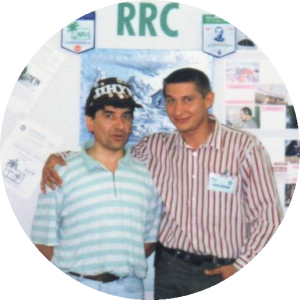 Ham Radio is something of incredibile!
Ham Radio is something of incredibile!
Being a radio amateur is certainly a privilege; Radio gives us the opportunity to travel the air, make connections all over the world, meet extraordinary people with whom growing lifelong friendships.
It’s the case of a friendship born more than 40 years ago, when for us, young Radioamateurs, looking for DX meant working the islands in the Arctic, the Antarctic bases, and proudly showing the QSLs confirming these contacts.
Well one of these friends, always active in the most remote places both in the Arctic and in Antarctica was and still is Valery Sushkov RW3GW, now RMØL!
 Valery Sushkov RMØL (ex RW3GW) is a travel researcher, postal historian, travel marketer, documentarian, chief postmaster of the International Philaturism Society, author of the new concept of “philaturism” in the history of world tourism practice, curator of the World Postal Mail Museum. Head of the Project “POSTVENTURE & Postal Adventure”. Visited more than 50 countries of the world, participant and organizer of more than 100 different expeditions on 6 continents, conqueror of the South
Valery Sushkov RMØL (ex RW3GW) is a travel researcher, postal historian, travel marketer, documentarian, chief postmaster of the International Philaturism Society, author of the new concept of “philaturism” in the history of world tourism practice, curator of the World Postal Mail Museum. Head of the Project “POSTVENTURE & Postal Adventure”. Visited more than 50 countries of the world, participant and organizer of more than 100 different expeditions on 6 continents, conqueror of the South 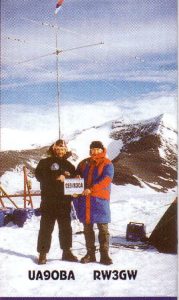 Pole and the highest peak in Africa – Mount Kilimanjaro, member of the Russian Geographical Society – Society for the Study of the Amur Region, member of the Union of Journalists of Russia, laureate and winner of the National Awards of the Russian Geographical Society “Crystal Compass”.
Pole and the highest peak in Africa – Mount Kilimanjaro, member of the Russian Geographical Society – Society for the Study of the Amur Region, member of the Union of Journalists of Russia, laureate and winner of the National Awards of the Russian Geographical Society “Crystal Compass”.
 Philaturism is educational and adventure tourism and the study of territories through the prism of philately and postal history, something new born from the fervent mondo f Valery!.
Philaturism is educational and adventure tourism and the study of territories through the prism of philately and postal history, something new born from the fervent mondo f Valery!.
For the development of philaturism, the project “POSTVENTURE & Postal Adventure” and the International Philaturism Community were created. Valery Sushkov RMØL (ex RW3GW) defines the project and community as a postal radio-telegraph historical adventure experiment. Together with like-minded people and partners, Valery Sushkov is implementing a project in the form of historical and postal reconstructions, special cancellation ceremonies, philaturist flash mobs, installation of postal monuments, the creation of postal routes and expeditions, philanthropic guides and philatelic products.
See: RM0M – Callsign Lookup by QRZ Ham Radio and https://www.rgo.ru/ru/article/master-klass-s-valeriem-sushkovym-filaturizm-novoe-ponyatie-v-mirovoy-praktike-turizma
 It’s a real shame! Six people visited Platcha Hut, a brand “New One” for many Antarctic Hunters, and nobody brought an HF Radio, to operate a little while from there, and living us the pleasure to log a rare spot in Antarctica!
It’s a real shame! Six people visited Platcha Hut, a brand “New One” for many Antarctic Hunters, and nobody brought an HF Radio, to operate a little while from there, and living us the pleasure to log a rare spot in Antarctica!
We just read the info posted today on FB page: «That’s one way to get to work! Expeditioners from Davis Research Station flew out to check in on the isolated Platcha Hut last week. The team of six got a lift from a helicopter that is currently at the station and had one of the most unique morning commutes in the AAP! »
There are a number of features close to Davis Station (WAP AUS-Ø3) which are the subject of regular recreational visits. These include Lake Dingle and Lake Stinear, the lakes nearest to the Station, Tarbuck Crag as the nearest high point, Weddell Arm for viewing Weddell Seals when appropriate, Ellis Rapids and Brookes Hut. Other field huts within the area, which are regularly used for recreational as well as scientific purposes are Platcha, Bandits, and Watts Lake Huts.
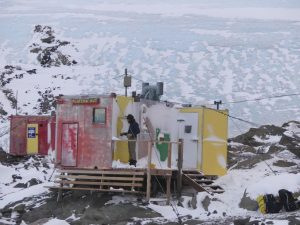 Platcha Hut 68° 30′ 47″ South, 78° 30′ 36″ East is situated in an extemely handy spot at the base of the plateau just to the south of Breid Basin a few metres above the shoreline. The locale is easy to reach by helicopter in the summer and is a decent walk over rough terrain from Davis Station for the keen. In the winter, Platcha Hut is one of the first to be visited once the sea ice forms and is thick enough. From Davis quads or Hägglunds, head along a waypointed route that follows Long Fjord to Breid Basin. The Hut itself sleeps four in bunk beds with room for two in the recently renovated (2011) Met Hut (the original Platcha) at the back.
Platcha Hut 68° 30′ 47″ South, 78° 30′ 36″ East is situated in an extemely handy spot at the base of the plateau just to the south of Breid Basin a few metres above the shoreline. The locale is easy to reach by helicopter in the summer and is a decent walk over rough terrain from Davis Station for the keen. In the winter, Platcha Hut is one of the first to be visited once the sea ice forms and is thick enough. From Davis quads or Hägglunds, head along a waypointed route that follows Long Fjord to Breid Basin. The Hut itself sleeps four in bunk beds with room for two in the recently renovated (2011) Met Hut (the original Platcha) at the back.
In the early 60s the original Hut was manned continuously by teams of two for a few weeks at a time. They were tasked with making meteorological observations.
 The present Platcha Hut was built in 1982. On the 9th of September the internal fit-out was transported to Platcha and by the 16th of September the hut was completed and ready for occupation which was a mammoth effort by the wintering team of 1982.
The present Platcha Hut was built in 1982. On the 9th of September the internal fit-out was transported to Platcha and by the 16th of September the hut was completed and ready for occupation which was a mammoth effort by the wintering team of 1982.
Thanks and credit to: Field huts around Davis – Australian Antarctic Program (antarctica.gov.au)
There are lots of Antarctic Hunters all over the world, who would love to work for the fist time on air Platcha Hut and for sure the other Huts scattered around the main Scientific bases in Antarctica.
From these pages, we, Radioamateurs launch an appeal to those responsible for scientific activities in Antarctica: Bringing a radio, setting up a couple of dipoles and doing a few hours of activity on HF is not just fun or recreation, but the study of radioionospheric propagation which could be part of the list of scientific experiments. Thank you
 Luis Risopatrón Refuge is an Antarctic Chilean refuge, located at 60°22’17” South, 59°42’53” West on the north shore of Coppermine Cove, Robert Island in Nelson Strait on South Shetland Islands
Luis Risopatrón Refuge is an Antarctic Chilean refuge, located at 60°22’17” South, 59°42’53” West on the north shore of Coppermine Cove, Robert Island in Nelson Strait on South Shetland Islands
The refuge lies 100 metres from the Antarctic Specially Protected Area ASPA No.112
Originally, it was called Coppermine Naval shelter and was inaugurated on March 20, 1949 by the Chilean Navy during the commission of Commodore Leopoldo Fontaine. By law No. 19087, enacted on September 24, 1991, the “shelter” was renamed Base Luis  Risopatrón, although, due to its characteristics it was known for quite a bit of time, as Luis Risopatrón Refuge. The shelter is located 40 m above sea level, on a solid rock surface, 150 m from the coast. 20 km from the closest base, Captain Arturo Prat, (WAP CHL-Ø1).
Risopatrón, although, due to its characteristics it was known for quite a bit of time, as Luis Risopatrón Refuge. The shelter is located 40 m above sea level, on a solid rock surface, 150 m from the coast. 20 km from the closest base, Captain Arturo Prat, (WAP CHL-Ø1).
The Base installation is made up of 5 modules. Scientific activities concerning terrestrial biology (since 1975) and geology and geophysics (since 1980) have been carried out there. The Base site, has a capacity for a staff of 12 people.
We must say that Risopatron Refuge should not be confused with the Luis Risopatrón Scientific  Antarctic Base, which did participate in the activities of the International Geophysical Year on March 3, 1957. This Base was set 60 meters from the O’Higgins Base (WAP CHL-Ø2) with civil resources belonging to the Catholic University of Chile.
Antarctic Base, which did participate in the activities of the International Geophysical Year on March 3, 1957. This Base was set 60 meters from the O’Higgins Base (WAP CHL-Ø2) with civil resources belonging to the Catholic University of Chile.
It was destroyed by fire on March 10, 1958, just a year after its opening.
.
WAP has no evidence of any recent Ham Radio operation from the Base or Refuge, whatever you want, while CE9AE seems to be (so far) the only one who did operate from the Base in 1957.
 Last march 10th 2024, the marathon for the “120th Anniversary” of Argentina’s presence in Antarctica has ended.
Last march 10th 2024, the marathon for the “120th Anniversary” of Argentina’s presence in Antarctica has ended.
It was not easy for EU to work the station active from the several LU Bases in Antarctica, as well as other callsign and Polar Ship involved, due to the operating GMT time non favorable for EU, but in spite of that, quite a few Hams did manage to work some!
Congrats to Estado Mayor Conjunto de las Fuerzas Armada, Comando Conjunto Antártico for the wonderful initiative. The marathon continue until the Antarctic campaign 2023-2024 will end; certificates are still available.
Not everybody has worked Icebreaker ARA Almirante Irízar yet, so our attention will now pointed on LU2AIB/MM, hoping to have this “new one” on the log as well, other than the pleasure to discharge the related certificate.
Look also for LU2ARM operating time to time, from the Joint Antarctic Command (EJERCITO ARGENTINO, DIRECCION ANTARTICA, in Buenos Aires, Capital Federal)
 All Digital Certificates, available to those who did work the Argentina’s Bases in Antartica and other official LU station which work within the event, could download their own confirmation by entering the QSLOG.AR website at:
All Digital Certificates, available to those who did work the Argentina’s Bases in Antartica and other official LU station which work within the event, could download their own confirmation by entering the QSLOG.AR website at:
QSLOG.AR – Bienvenidos!!! al Sitio Integrado de QSLOG.AR
TNX : Estado Mayor Conjunto de las Fuerzas Armada, Comando Conjunto Antártico
and
LU3IA Alfredo Arcangel Amaro (pic on the right) for his envaluable help and timely information on the activities of the various LU’s Antarctic stations.
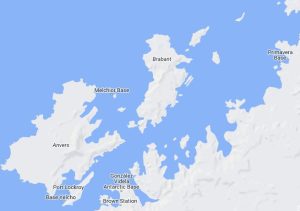 Brabant Island, lying off the west coast of the Antarctic Peninsula at 64°15’South, 62°20’West, is the second largest Island of the Palmer Archipelago within the British Antarctic Territory. Brabant Island, 59 km (37 mi) long north-south, 30 km (19 mi) wide, is lying between Anvers Island and Liège island. It had only been visited on six very brief occasions since its discovery in 1898, although a 1/200 000 topographic map had been produced in 1963 from FIDASE aerial photography.
Brabant Island, lying off the west coast of the Antarctic Peninsula at 64°15’South, 62°20’West, is the second largest Island of the Palmer Archipelago within the British Antarctic Territory. Brabant Island, 59 km (37 mi) long north-south, 30 km (19 mi) wide, is lying between Anvers Island and Liège island. It had only been visited on six very brief occasions since its discovery in 1898, although a 1/200 000 topographic map had been produced in 1963 from FIDASE aerial photography.
Joint Services Expedition explored the island in three phases over a 15-month period, from January 1984 to March 1985; each phase was landed and recovered by HMS Endurance. The aims of the expedition were primarily scientific and secondarily adventurous.
HMS Protector returned recently to Brabant Island for the first time since 2017 to continue work to remove abandoned equipment from the 1980’s expedition.
Royal Navy sailors have helped preserve the natural beauty of Antarctica by removing three tons of waste that had frozen into position but subsequent thaw and freeze cycles meant it could now be removed seven years on. Twenty-nine members of HMS Protector’s expedition headed ashore on the ship’s Zodiac boats. “It was quite shocking seeing all the mess left behind at first. But once we got together to gather up all the rubbish, we could instantly see the benefits of our work, quite a bitter-sweet”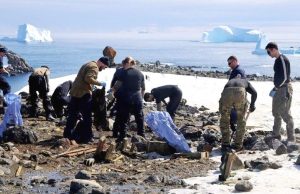
HMS Protector is the Royal Navy’s Polar Research ship and is currently deployed in the Antarctic region promoting British interests and enforcing the Antarctic Treaty by working with partners including the British Antarctic Survey (BAS), United Kingdom Antarctic Heritage Trust and the governments of the Falkland Islands, South Georgia and South Sandwich Islands.
TNX and credit: HMS Protector removes waste from Brabant Island next to Antarctica Peninsula — MercoPress
Well, maybe someone from the nearby Argentine Base Melchior (WAP ARG-13) can try to visit Brabant for a brief stay, or someone of the BAS can operate from there on one of the next visit!
Watch the Brabant Island Expedition Film 1983-85 here below
 As widely announced, last month of February, the 21st edition of the Antarctic Activity Week took place. (see: http://www.waponline.it/antarctic-activity-week/aaw-2024/)
As widely announced, last month of February, the 21st edition of the Antarctic Activity Week took place. (see: http://www.waponline.it/antarctic-activity-week/aaw-2024/)
All the participating stations with their own “Special Call” and the related WAP reference did report the large participation of radioamateurs and in many cases, they experienced a significant pile-up!
Many Hunters have already requested the certificate which, like every year, is offered free of charge to the participants, by our dear friend IK3GER Paolo Corsetti, whom we will never stop thanking.
An Antarctic diploma displayed in the shack of any DXer, makes a nice show and looks like a certification of a particular interest and, in the spirit of WAP, it demonstrates the sensitivity of radio amateurs towards scientific research and the love for a Continent like Antarctica, a land of study and PEACE.
The picture above, shows the diploma got by our friends Volker Strecke DL8JDX who did participate as Hunter in the 21st edition of the AAW 2023 which has just ended.
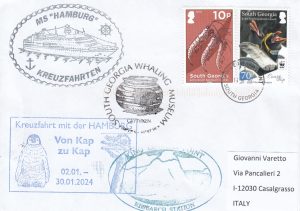 WAP is proud to show an envelope posted directly from South Georgia, by Dr. Volker Strecke DL8JDX on the last of his cruise to Antarctica.
WAP is proud to show an envelope posted directly from South Georgia, by Dr. Volker Strecke DL8JDX on the last of his cruise to Antarctica.
The South Georgia Museum is located in the old whaling Station of Grytviken (WAP GBR-29). The building was once the whaling manager’s home and office.
The museum was established by Nigel Bonner in 1991 as a whaling museum. Its scope now embraces all the main areas of island’s history, including most aspects of South Georgia’s human heritage and natural history.
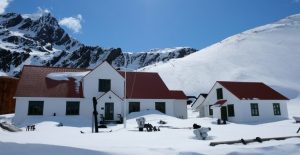 Exhibits include discovery, exploration, Shackleton, surveying and mountaineering expeditions, sealing in the late 18th and early 19th centuries, the early days of whaling, techniques of modern whaling in the middle part of the 20th century, whalers’ social life, maritime history, and natural history. Displays also cover the 1982 conflict and subsequent British military presence until 2001.
Exhibits include discovery, exploration, Shackleton, surveying and mountaineering expeditions, sealing in the late 18th and early 19th centuries, the early days of whaling, techniques of modern whaling in the middle part of the 20th century, whalers’ social life, maritime history, and natural history. Displays also cover the 1982 conflict and subsequent British military presence until 2001.
 GSGSSI has responsibility for the operational buildings and infra-structure associated with the museum. The South Georgia Heritage Trust took over the management of the museum in July 2006.
GSGSSI has responsibility for the operational buildings and infra-structure associated with the museum. The South Georgia Heritage Trust took over the management of the museum in July 2006.
TNX Volker DL8JDX
.
Get more at: South Georgia Museum – Government of South Georgia & the South Sandwich Islands
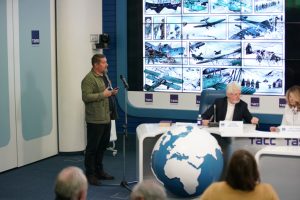 A press conference, a special post card cancellation ceremony, and a presentation of a quest route was held in Moscow in honor of the 90th Anniversary of the heroic epic of the rescue of the Chelyuskints and the establishment of the title of Hero of the Soviet Union.
A press conference, a special post card cancellation ceremony, and a presentation of a quest route was held in Moscow in honor of the 90th Anniversary of the heroic epic of the rescue of the Chelyuskints and the establishment of the title of Hero of the Soviet Union.
Speaker RMØL (ex RW3GW) Valery Sushkov, DX-peditioner on the Arctic and Antarctica. (see pic aside)
On February 13, 1934, the radio operator of the Chelyuskin steamship, Ernst Krenkel, sent a radiogram to Moscow about the loss of the ship. 104 people, including 2 children, remained on the ice. From that moment on, an heroic air rescue operation began, which lasted 2 months. In April 1934, 7 polar pilots became the first Heroes of the Soviet Union in the USSR.
On February 13, 2024, at the Federal Information Agency of Russia “TASS” (Moscow, Tverskoy Boulevard, building 2, 2nd floor) a press conference was held, a special cancellation ceremony for a postal card with a stamp and a presentation of the quest route of the All-Russian Public Committee “Chelyuskintsy” “, dedicated to the celebration of the 90th Anniversary of the Chelyuskin epic and the appearance of the title of Hero of the Soviet Union https://chelyuskincy.ru
 At the end of the press conference, a solemn ceremony of special cancellation of a special postal card and a stamp with a limited edition and a presentation of the city memorial, historical, cultural and philaturist quest route in Moscow, took place.
At the end of the press conference, a solemn ceremony of special cancellation of a special postal card and a stamp with a limited edition and a presentation of the city memorial, historical, cultural and philaturist quest route in Moscow, took place.
The author of the postcard, vignette stamp, special postmark, as well as a quest route in honor of the 90th Anniversary of the heroic epic of saving the Chelyuskinites and the establishment of the title of Hero of the Soviet Union was a travel researcher, postal historian, author and director of the All-Russian project for the development of philaturism “POSTVENTURE & Postal Adventure” , member of the PKO RGS-OIAC and the Union of Journalists of Russia, Valery Sushkov (RMØL ex RW3GW).
Artist: Vladislav Serov, Designer: Natalya Pligina.
WAP readers and everyone interested, can pre-order a new postal card (edited No. 2, which plans to be released on April 13, 2024) with a vignette stamp and a special postmark in honor of the 90th anniversary of the heroic Chelyuskin epic and the appearance of the title of Hero of the Soviet Union by contacting the issuer: All-Russian Philatourism Development Project “POSTVENTURE & Postal Adventure”. Tel./WhatsApp: +7-950-805-22-11, E-mail: info@postventure.ru
TNX Oleg UA6GG (Polar DX Trophy)
 WAP Antarctic Bulletin nr. 302, released on Febr. 18th 2024 is available online with last info and reported activity from Antarctica.
WAP Antarctic Bulletin nr. 302, released on Febr. 18th 2024 is available online with last info and reported activity from Antarctica.
Bull 302 is downloadable at: http://www.waponline.it/wap-antarctic-bulletins/
This issue contains the information and the guide for the important Argentine Activity (22 February-10 March 2024) to celebrate the 120 years of continuous presence of Argentina in Antarctica and the related available Certificate.
TNX Max IK1GPG and Betty IK1QFM, editors of WAP Antarctic Bulletins.
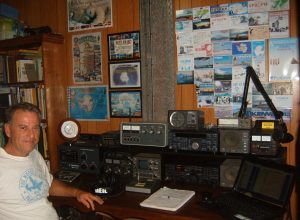 John (SK), formerly VK2FR and VK2ANT, was a skilled radio Ham that spoke to many people around the world including those at Antarctic Bases and research stations over the last four decades.
John (SK), formerly VK2FR and VK2ANT, was a skilled radio Ham that spoke to many people around the world including those at Antarctic Bases and research stations over the last four decades.
His daughter Aimee sent WAP some photos from her trip to Antarctica. «It was absolutely amazing and such a special pilgrimage. Aimee and her hausband Adam visited Chilean station González Videla and Argentina’s Almirante Brown. Although there wasn’t anyone based at Brown at the time, it was incredible to see the station which was also home to hundreds of Gentoo penguins. I am keen to go back again and visit South Georgia Islands next time. I was just in awe of Antarctica, what a sacred place!».
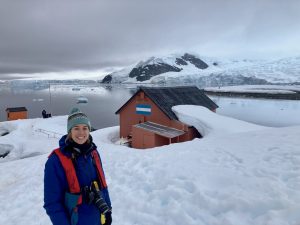 Aimee Sharpe wrote: For as long as I can remember, I would listen to my father communicate over the radio, fascinated by the secret language of morse code as he bounced and beeped through the ionosphere until the early hours of the morning. His great love was Antarctica and it was his dream to travel there together one day. He was a proud member of the Antarctic Ham community and held several Antarctic Awards including WAP-WACA, WAP-WADA, Wireless Institute of Australia Antarctic Award as well as the United Nations Honor Roll.
Aimee Sharpe wrote: For as long as I can remember, I would listen to my father communicate over the radio, fascinated by the secret language of morse code as he bounced and beeped through the ionosphere until the early hours of the morning. His great love was Antarctica and it was his dream to travel there together one day. He was a proud member of the Antarctic Ham community and held several Antarctic Awards including WAP-WACA, WAP-WADA, Wireless Institute of Australia Antarctic Award as well as the United Nations Honor Roll.
After my father died suddenly in January 2021, I travelled to Antarctica in honour of him (see pic of Aimee aside). It was a sacred pilgrimage for me and an experience that irrevocably changed my life.
One of the happiest moments from the trip was landing at Almirante Brown, an Argentinian research base in the Antarctic Peninsula that is home to hundreds of Gentoo Penguins. I had a laugh to myself when I saw that the radio tower was the same size as the one that my dad built in our backyard… at least there weren’t any neighbours to annoy with this tower, and the penguins didn’t seem fazed!
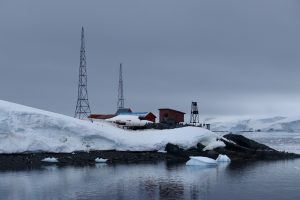 The WAP Antarctic Activity Week has just begun and runs until next Sunday (18-25 February 2024). During this week, radio amateurs from around the world will be contacting the women and men who are away from their homes and families on the southernmost Continent.
The WAP Antarctic Activity Week has just begun and runs until next Sunday (18-25 February 2024). During this week, radio amateurs from around the world will be contacting the women and men who are away from their homes and families on the southernmost Continent.
-Ahead of the 21st Worldwide Antarctica Program’s Antarctic Activity Week, the Australian National Maritime Museum received a special visit from Aimee Sharpe. She met with staff and volunteers at the museum to inspect the radios aboard our vessels and share her father’s story- reported the Volunteers.
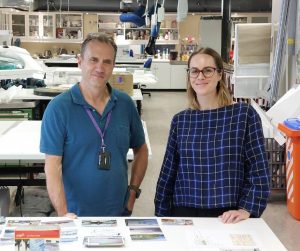 The Australian National Maritime Museum is proud to have volunteer Amateur Radio Operators, who transmit and receive from the radio room of HMAS VAMPIRE (VK2VMP).
The Australian National Maritime Museum is proud to have volunteer Amateur Radio Operators, who transmit and receive from the radio room of HMAS VAMPIRE (VK2VMP).
Those who are experienced radio amateurs and are interested in joining the team, please get in touch. www.sea.museum/support/volunteer. (pic on the right : Aimee Sharpe and Stirling Smith, Archeologist and Curator at the ANMM – Australian National Antarctic Museum in Sydney)
TNX Aimee Sharpe for joining us during the AAW and leaving us a great recall of our real good friend as John VK2FR was!
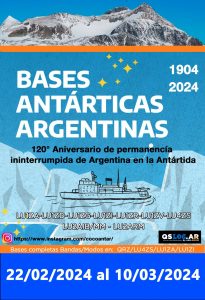 Beside the WAP’s Antarctic Activity Week which runs from 18th to 25th february, another important event recalls the WW Ham radio community, the so called “Dia de la Antartida Argentina” which is celebrate yearly on 22 february.
Beside the WAP’s Antarctic Activity Week which runs from 18th to 25th february, another important event recalls the WW Ham radio community, the so called “Dia de la Antartida Argentina” which is celebrate yearly on 22 february.
Historical reference:
“Dia de la Antartida Argentina” (Argentine Antarctic Day-Law 20,827) commemorates the inauguration, on February 22, 1904, of the Meteorological Observatory on Laurie Island, South Orkney, which would later become the Orkney Base (WAP ARG-15), a historical milestone that marked the beginning of the uninterrupted connection of Argentina in Antarctica.
Since this event, Argentina has maintained a permanent and uninterrupted presence on the Antarctic continent for 120 years.
On its “120th Anniversary” a “digital certificate with 5 contacts” has been issued to celebrate the event, which will be held from February 22 to March 10, 2024.
This Digital Certificate, will be available for working five (5) stations of the Joint Antarctic Command.
Icebreaker ARA Almirante Irízar and the joint Antarctic bases listed below will be “On Air” for the national and international radio amateurs (and SWL) community.
Look for the followings:
LU1ZA Orcadas Antarctic Joint Base (WAP ARG-15)
LU1ZD Gral. San Martín Antarctic Joint Base (WAP ARG-Ø8)
LU1ZG Belgrano II Antarctic Joint Base (WAP ARG-Ø6)
LU1ZI Carlini Antarctic Joint Base (WAP ARG-2Ø)
LU1ZR Petrel Antarctic Joint Base (WAP ARG-17)
LU1ZV Esperanza Antarctic Joint Base (WAP ARG-Ø4)
LU4ZS Vcom Antarctic Joint Base. Marambio (WAP ARG-21)
LU2ARM Joint Antarctic Command
LU2AIB/MM Icebreaker ARA Almirante Irízar
 Date: February 22 to March 10, 2024.
Date: February 22 to March 10, 2024.
Schedule: Subject to operational activities and tasks on 80, 40, 30, 20, 17, 15, 12, 10 mts
Modes: CW – SSB – FT8 – RTTY – PSK
Exchange: Only signal report (RST) is required
Task: To obtain the certificate you must be able to contact 5 calls of the above list.
Operation: Subject to time availability of Antarctic operators and propagation conditions.
Argentine and foreign Amateur radio stations will be able to download their QSL by entering the integrated system (QSLOG.AR) through the website www.qslog.com.ar in the activities tab, once the event has ended and the logs have been processed.
Hams should NOT send any logs. If you do not see your QSL/Certificate reflected, you must contact the event organizer in order to verify your QSO data.
SWLs could confirm the listening of each station, sending all the corresponding data to the email (qslantartida@fuerzas-armadas.mil.ar , lu3ia@hotmail.com) subsequently downloading in the same way the corresponding QSL of each operator listened to.
TNX : Estado Mayor Conjunto de las Fuerzas Armada, Comando Conjunto Antártico and LU3IA Alfredo Arcangel Amaro
 Wilkins Aerodrome at 66°41’27″South, 111°31’35″East is named after the legendary patron and pioneer of early Antarctic aviation, Sir Hubert Wilkins.
Wilkins Aerodrome at 66°41’27″South, 111°31’35″East is named after the legendary patron and pioneer of early Antarctic aviation, Sir Hubert Wilkins.
Wilkins Aerodrome is a major summer-only facility. is located approximately 70 km southeast of Casey Research Station (WAP AUS-Ø2) and serves as the Antarctic terminal for the intercontinental air service.
Situated in an area of Antarctica known as Wilkes’ Land, the aerodrome has been sited 700 metres above sea level to minimise the likelihood of melt, as the coast is relatively warm by Antarctic standards during the summer months.
The Wilkins site is approximately 70% exposed ice and 30% snow cover that is less than one metre deep. The foundation of the runway is natural glacial ice, rolled with proof rollers to  ensure that the surface ice has suitable bearing strength and integrity to support the aircraft.
ensure that the surface ice has suitable bearing strength and integrity to support the aircraft.
The runway surface is tillered by a snowgroomer to manufacture higher friction levels prior to each flight of a wheeled aircraft.
The facility operates between October and March each year. It closes for around six weeks at the height of summer, due to warmer temperatures causing sub-surface melt.
.
So far, nobody has been operated Hamradio from Wilkins, which still remains unnumbered; that’s why we hope one day or another some zealous Radio amateur can do it.
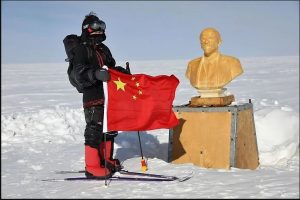 Chinese explorer and adventurer, Feng Jing, hiked to the Southern Pole of Inaccessibility (POI), which is the farthest point from all the coastlines of Antarctica.
Chinese explorer and adventurer, Feng Jing, hiked to the Southern Pole of Inaccessibility (POI), which is the farthest point from all the coastlines of Antarctica.
With two assistants she reached the POI after 80 days on January 25, 2020. It is a remarkable achievement traversing over 1,800 kilometers in extreme conditions; one fascinating aspect to the trip is that there is a Lenin statue at the Pole of Inaccessibility! No one had ever reached the spot on foot before and also, very few people have ever visited this inhospitable spot.
.
Have a look at the video below (start it at min 2:09)
Pole of Inaccessibility (aka Polyus Nedostupnosti Station)
In 1958 the Soviet Union sent an expedition of scientists there, with the goal of establishing a Base Camp at 82° 06’ South, 54°58’East. Equipment and personnel were delivered by an Antarctic tractor convoy operated by the 3rd Soviet Antarctic Expedition. 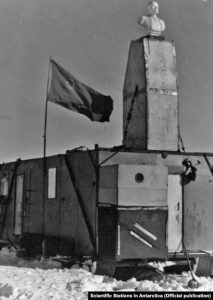 The station had a hut for four people, a radio shack, and an electrical hut. These buildings had been constructed on the tractors used during the traverse, serving as accommodation. On top of the camp structures, they placed the Lenin bust. Next to the hut, an airstrip was cleared and a Li-2 aircraft landed there on 18 December 1958. The outpost was equipped with a diesel power generator and a transmitter. Pole of Inaccessibility Station performed meteorological observations from 14 to 26 December 1958.
The station had a hut for four people, a radio shack, and an electrical hut. These buildings had been constructed on the tractors used during the traverse, serving as accommodation. On top of the camp structures, they placed the Lenin bust. Next to the hut, an airstrip was cleared and a Li-2 aircraft landed there on 18 December 1958. The outpost was equipped with a diesel power generator and a transmitter. Pole of Inaccessibility Station performed meteorological observations from 14 to 26 December 1958.
On 26 December the outpost was vacated indefinitely. Four researchers were airlifted out, and the remaining 14 members of the party returned with the tractors. The Station was deemed to be too far from other Research Stations to allow safe permanent operation, so it was left to be used for future short-term visits only. The Pole of Inaccessibility has the world’s coldest year-round average temperature of −58.2 °C (−72.8 °F).
The camp was essentially abandoned and only a handful of people have travelled there. The camp buildings were buried by snow over the last 60 years, but incredibly Lenin is still visible and there unharmed having survived despite it all.
Read more about Pole of Inaccessibility at: The Pole Or Bust! The Loneliest (And Coldest) Lenin (rferl.org)
 The 8th Soviet Antarctic Expedition visited the site on 1 February 1964 and left five days later.
The 8th Soviet Antarctic Expedition visited the site on 1 February 1964 and left five days later.
The American Queen Maud Land Traverse, reached the Pole of Inaccessibility from Amundsen-Scott South Pole Station (WAP USA-21) on 27 January 1965. The crew were flown out by a Lockheed C139 Hercukes on 1 February. On 15 December 1965 a new American crew arrived by C-130 to make observations, refurbish the snow cats, and continue the Queen Maud Land Traverse, zig-zagging to the newly installed Plateau Station (WAP USA-13) where they arrived on 29 January 1966.
The 12th Soviet Antarctic Expedition visited the site in 1967.
On 19 January 2007, the British Team N2i reached the Pole of Inaccessibility using specially-designed foil kites.
On 27 December 2011, during the Antarctica Legacy Crossing, Sebastian Copeland, and partner Eric McNair-Landry, reached the Pole of Inaccessibility by foot and kite ski from Novolazarevskaya Station (WAP RUS-Ø9), on their way to completing the first partial east–west transcontinental crossing of Antarctica of over 4,100 km (2,500 mi).
The station building is surmounted by a bust of Vladimir Lenin facing Moscow. It is almost entirely buried by snow, with little more than the bust visible.
Following a proposal by Russia to the Antarctic Treaty Consultative Meeting, the buried building and emergent bust, along with a plaque commemorating the conquest of the Pole of Inaccessibility by Soviet Antarctic explorers in 1958, has been designated a Historic Site or Monument (HSM 4).
Speaking as a Radioamateur, I must say that it is a real shame that, for some years in Antarctica, the Hamradio culture has no longer had the importance it once did.
That several expeditions, like these ones over the last 50 years to the Pole of Inaccessibility Station, were not accompanied by radio operators to give radio amateurs from all over the world the chance to contact a place so full of history, let me say, is truly a shame! Let’s hope that, before too long, a new expedition could operate HF from Pole of Inaccessibility Station (HSM#4)!
To all the Hams collecting Polar Ship, WAP reminds that Fragata ARA Libertad is valid for WAP Awards as well as for Polar DX Challenge.
 February 10, 11 and 12, 2024, the Argentine Ship Fragata ARA Libertad will be on air for 3 days. It will be a chance, an opportunity not to be missed!
February 10, 11 and 12, 2024, the Argentine Ship Fragata ARA Libertad will be on air for 3 days. It will be a chance, an opportunity not to be missed!
Within the framework of a great celebrations, the ARA Frigate Training Ship “LIBERTAD”, will moored at Mar del Plata Naval Base to honor the 150th Anniversary of the founding of the City of Mar del Plata.
LU8AEU will be on air CW, SSB, FT8, FM on 10,20,40, and 2 meters at 10:00 a.m. to 8:00 p.m LU time which correspond at 14:30 through 24:00 GMT. A Memorial QSL will be issued to a single contact
LU8AEU will be operated by volunteer members of the Auxiliary Radio Amateur Service of the Navy, from the Mar del Plata Naval Base.
 Argentine and Foreign Amateur Radio Stations will be able to download their QSL by entering the QSLOG.AR integrated system, through the website www.qslog.com.ar , once the event has ended and the Logs have been processed.
Argentine and Foreign Amateur Radio Stations will be able to download their QSL by entering the QSLOG.AR integrated system, through the website www.qslog.com.ar , once the event has ended and the Logs have been processed.
In case you do not see your QSL coming up, you must contact the event organizer in order to verify your QSO data.
The SWL stations will be able to confirm the listening of each station, sending all the corresponding data to the email (arasaraeventos@gmail.com ) subsequently downloading in the same way the corresponding QSL of each operator listened to.
TNX Armada Argentina and the Friends of Fragata Libertad.
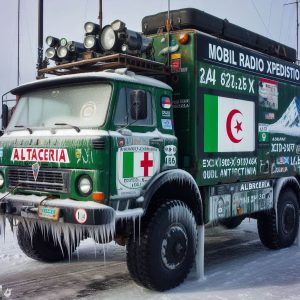
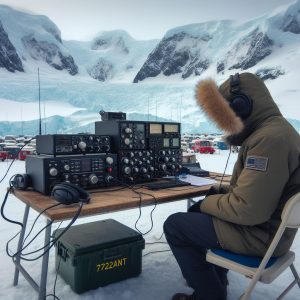 Kamel Ghalem, 7X2GK will participate in the 21st Antarctic Activity Week with the special callsign: 7T22ANT (WAP-345) from 15th through 25th February 2024. QSL manager : IK2DUW
Kamel Ghalem, 7X2GK will participate in the 21st Antarctic Activity Week with the special callsign: 7T22ANT (WAP-345) from 15th through 25th February 2024. QSL manager : IK2DUW
Kamel wrote: Last year we participated in the 20th AAW with the same invitation, and it was a good and useful experience for all of us. This is the third participation in a row and we hope that this year will be better.
Best wishes from Algeria, 73 de Kamel
Algeria is the first African Country to join the Antarctic Activity Week and this is a great goal.
WAP wish Kamel Ghalem to repeat the positive experience of the past years and welcomes 7T22ANT again on board, sure that everyone chasers will contact him on the bands.
 An interesting article published at: https://polarjournal.ch/en/2024/01/31/meet-the-czech-scientists-who-convinced-their-government-to-go-to-antarctica/?fbclid=IwAR3oKt7Ny65_Hs8NENd4R-10MJgaub-HbZ398NfRtyBobNotHLV_OQLPDAE remind us that one of the rare Antarctic Station “Gregor Mendel” (WAP CZE-NEW), has been recently reopened . The main part of the expedition team has left on 24 January for the Mendel Polar Station on James Ross Island, where they will arrive around Febr. 9th to spend two months there.
An interesting article published at: https://polarjournal.ch/en/2024/01/31/meet-the-czech-scientists-who-convinced-their-government-to-go-to-antarctica/?fbclid=IwAR3oKt7Ny65_Hs8NENd4R-10MJgaub-HbZ398NfRtyBobNotHLV_OQLPDAE remind us that one of the rare Antarctic Station “Gregor Mendel” (WAP CZE-NEW), has been recently reopened . The main part of the expedition team has left on 24 January for the Mendel Polar Station on James Ross Island, where they will arrive around Febr. 9th to spend two months there.
Actually the Czech team consists of 24 participants; nine researchers (two of them women, one of them from Charles University), one doctor, four technicians and a two-member film crew consisting of Petr  Horký, a traveller and documentary filmmaker, as well as an experienced polar explorer who has made expeditions to the three poles of the Earth (North, South and the Cold Pole), and Jan Šimánek, a cameraman. They will be shooting a unique documentary about the Czech Antarctic Research Programme for Czech Television.
Horký, a traveller and documentary filmmaker, as well as an experienced polar explorer who has made expeditions to the three poles of the Earth (North, South and the Cold Pole), and Jan Šimánek, a cameraman. They will be shooting a unique documentary about the Czech Antarctic Research Programme for Czech Television.
It’s a great news for the “Antarctic Chasers”; let’s hope it could be possible that in a near future some Ham radio operation could be performed down there as well. The station is the property of Masaryk University in Brno and was named after the father of modern genetics, the meteorologist Gregor Johann Mendel
Some members of the expedition are at the Eco Nelson Base  (WAP CZE-Ø1) on Nelson Island. This smaller expedition will last at Echo Nelson six weeks in total, of which, almost four weeks will be spent working on King George Island and Nelson Island. At the end of this part of the expedition, two participants will travel to the Ukrainian station Vernadsky
(WAP CZE-Ø1) on Nelson Island. This smaller expedition will last at Echo Nelson six weeks in total, of which, almost four weeks will be spent working on King George Island and Nelson Island. At the end of this part of the expedition, two participants will travel to the Ukrainian station Vernadsky 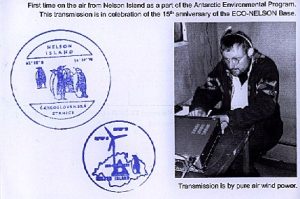 (WAP UKR-Ø1) on Galindez Island to continue working on the joint Czech-Ukrainian research project, and will return to Europe in early May.
(WAP UKR-Ø1) on Galindez Island to continue working on the joint Czech-Ukrainian research project, and will return to Europe in early May.
TNX Český antarktický výzkumný program
Mendel Polar Station is a “New One” for Radioamateurs WW, who are collecting contacts in HF with the Antarctic Bases. WAP did suggest the Český antarktický výzkumný program that it will be great if Mendel Polar Station coul be “On Air” for the 1st time. Testing HF propagation from Antarctica is not only an exercise, but something of science!
They are good and clever guys, let’s hope that our appeal will be heard!
See the interesting video at: Czech researchers depart for new Antarctic station | Radio Prague International
 On 23 January 1954, Argentine Navy personnel did inaugurate the Cabo Primavera Refuge (now Capitán Cobbett Naval Refuge) on a rocky promontory on Cape Primavera. Over many years this building was used by Argentine exploration expeditions to the area to collect Meteorology and Biology data.
On 23 January 1954, Argentine Navy personnel did inaugurate the Cabo Primavera Refuge (now Capitán Cobbett Naval Refuge) on a rocky promontory on Cape Primavera. Over many years this building was used by Argentine exploration expeditions to the area to collect Meteorology and Biology data.
On March 3, 1977, the Antarctic Command of the Argentine Army did inaugurate Base Primavera (see picture below) following the works to the Refuge and the construction of new buildings.
The Summer Capitán Cobbett Naval Refuge that serves Base Primavera, (WAP ARG-Ø9), is a small building that currently has the function of a laboratory; it has two rooms and a bathroom, and has supplies for three men for three months. The refuge was renovated, in March 2017, by a task force of the transport ship ARA Bahia San Blas
 A bit of history
A bit of history
The Naval Refuge “Cabo Primavera” has been established 70 years ago, (January 23, 1954), within the Argentine Antarctic sector, Costa Danco, Tierra de San Martín.
Located in Cierva Cove, in the Antarctic Peninsula at 64°9’17” South, 60°54’21” West, the Navy Refuge currently called “Capitán Cobbett”, in memory of the Navy Captain Enrique Cobbett, who lost his life in the shipwreck of the frigate Buenos Aires off Cape Horn, in August 1826. It happened when he was preparing to reinforce Admiral Brown’s squadron in combat with the imperial forces of Brazil.
At the light of the last information collected, Capitan Cobbett Refuge (aka Cabo Primavera Refuge) will be add to the WAP-WADA Directory as , in the waiting of a possible activation!
Eric F5SIH is re-joining the Antarctic Activity Week after years of non-presence. Eric will operate as TM1ANT, WAP-Ø37, in tandem with Tom F4HWS
Eric wrote: «I’ will be active again with TM1ANT during the next 21st AAW. Just got the license. Two operators, Eric F5SIH ans Tom F4HWS» .
73, TM1ANT, F5SIH Eric.
 Eric sent us a preview of the new QSL of TM1ANT expressly designed for the 2024’s AAW .
Eric sent us a preview of the new QSL of TM1ANT expressly designed for the 2024’s AAW .
The image on the QSL, comes from a photograph taken by David Brunet F4FKT/FT4YM when he was in Antarctica. It’s a tribute and at the same time, a recognition of the emotions that David FT4YM was able to give us during his missions (2021-2023) from some rare Bases and remote sites following the scientific French-Italian expeditions on the Antarctic plateau.
TNX Eric F5SIH & Tom F4HWS, welcome on board!
We just remind the Worldwide Ham radio operators the date of the 21st AAW which will be held from 18th through the 25th of February 2024 (Check: http://www.waponline.it/antarctic-activity-week/aaw-2024/ ) . Don’t forget to join the event, it will be our small contribution to the conservation of Antarctica as a land of study and peace.
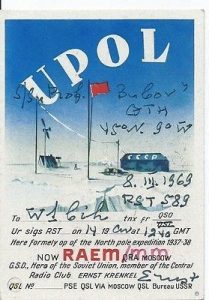 In the summer of 1924 Ernst Krenkel went to Leningrad with what little money he had saved, hoping to find employment as the radio operator on any ship undertaking a long voyage. At that time, only specially designated Soviet vessels went on long voyages, and in Leningrad there were already qualified naval radio operators without work. Just when Krenkel had given up all hope of finding work he was told that the hydrographic management bureau was in urgent need of a radio operator prepared to go on any expedition, to any island in the Arctic ocean. There was little interest because the pay was poor and it was necessary to be away for the whole year, living in ‘hellish’ conditions.
In the summer of 1924 Ernst Krenkel went to Leningrad with what little money he had saved, hoping to find employment as the radio operator on any ship undertaking a long voyage. At that time, only specially designated Soviet vessels went on long voyages, and in Leningrad there were already qualified naval radio operators without work. Just when Krenkel had given up all hope of finding work he was told that the hydrographic management bureau was in urgent need of a radio operator prepared to go on any expedition, to any island in the Arctic ocean. There was little interest because the pay was poor and it was necessary to be away for the whole year, living in ‘hellish’ conditions.
Ernst rushed around for an interview, and was offered a post. With a small advance on his salary, and  wearing his new naval uniform he set off by train to Arkhangelsk (Archangel). On arrival he was assigned to the “ Yugorski Shar “ which was preparing to take the relief crew to the first Soviet polar observatory “Matochkin Shar”, constructed the year before on the northern coast of the Matochkin Shar strait of the Novaya Zemlya archipelago.
wearing his new naval uniform he set off by train to Arkhangelsk (Archangel). On arrival he was assigned to the “ Yugorski Shar “ which was preparing to take the relief crew to the first Soviet polar observatory “Matochkin Shar”, constructed the year before on the northern coast of the Matochkin Shar strait of the Novaya Zemlya archipelago.
After returning to Moscow the following year he was enlisted in the Red Army and served in the radiotelegraphic battalion in Vladimir. At around this time the USSR government decided to allow ‘private radio stations’ on the short-waves.  Ham radio was born in the USSR and Ernst Krenkel was delighted. Soon he was on-air using homebrew equipment, with the callsign EU2EQ (later U3AA).
Ham radio was born in the USSR and Ernst Krenkel was delighted. Soon he was on-air using homebrew equipment, with the callsign EU2EQ (later U3AA).
This is just a brief anticipation of what is well reported in the detailed article available with lots of historic pictures which tell of the heroic deeds of Ernst Krenkel RAEM.
Read the whole history at: https://qst.su/archives/29525
But Ernst Krenkel traveled also to Antarctica and operated under the call RAEM/MM in 1968/1969. Thanks to Oleg UA6GG for providing WAP few historical QSLs shown above, which confirm Krenkel’s radio operations activity in Antarctica
TNX Oleg UA6GG
www.dxtrophy.com
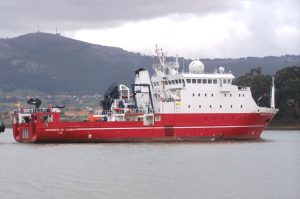 The Oceanographic Vessel (B/O) Sarmiento de Gamboa is a multidisciplinary research vessel with a global non-polar scope. Its instrumentation and laboratories allow it to carry out studies of global ocean circulation, marine biodiversity, fishery resources and climate change; It is also used to perform work in geology, marine geophysics, hydrography, physical and chemical oceanography, marine biology, resource estimation (fisheries), ocean monitoring with remotely operated vehicles (ROVs, AUVs, submarines, etc.), and deployment of underwater observatories (OBSEA, GEOSTAR)
The Oceanographic Vessel (B/O) Sarmiento de Gamboa is a multidisciplinary research vessel with a global non-polar scope. Its instrumentation and laboratories allow it to carry out studies of global ocean circulation, marine biodiversity, fishery resources and climate change; It is also used to perform work in geology, marine geophysics, hydrography, physical and chemical oceanography, marine biology, resource estimation (fisheries), ocean monitoring with remotely operated vehicles (ROVs, AUVs, submarines, etc.), and deployment of underwater observatories (OBSEA, GEOSTAR)
The research carried out there is fundamentally directed and financed by the National Plan for R+D+i.
 It also has the most advanced technologies in terms of navigation systems (for example, dynamic positioning) and is the first Spanish oceanographic vessel that can work with high-depth ROVs (Remote Operated Vehicles) and AUVs (Autonomous Underwater Vehicle).
It also has the most advanced technologies in terms of navigation systems (for example, dynamic positioning) and is the first Spanish oceanographic vessel that can work with high-depth ROVs (Remote Operated Vehicles) and AUVs (Autonomous Underwater Vehicle).
The B/O Sarmiento de Gamboa belongs to the CSIC and is based in Vigo, where it was launched in 2006. The Marine Technology Unit (UTM) of the CSIC is responsible for the management of the vessel as well as the maintenance of the scientific equipment and provides the technical staff to carry out the oceanographic campaigns.
One day or another On Air? ….
 Kottas camp (74°12′ South, 9°44′ West) is a German Field Camp at Dronning Maud Land, Antarctica has been add to WAP-WADA Directory .
Kottas camp (74°12′ South, 9°44′ West) is a German Field Camp at Dronning Maud Land, Antarctica has been add to WAP-WADA Directory .
The German contribution to the ITASE programme was carried out during 5 years (2004-2008) , mainly in the frame of the EPICA pre-site survey in Dronning Maud land, along the traverse route from Neumayer Station across Ritscherflya and Kottasberge, Heimefronfjella to Amindsen.
The traverse were carried out by Alfred Wegener Institute for Polar and Marine Research, Bremenhaven (AWI).
Stake readings for accumulation studies across Ekstromsen and Ritcherflya was carried out each field seson. 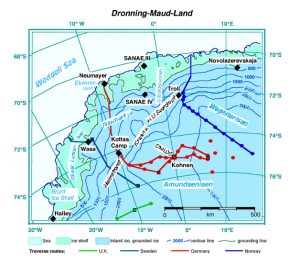 The 460km long stake line comprises approximately 950 stakes . It starts 10 km South of Neumayes at 70°41.83’ South, 8°26’24” West and ends after the crossing of Kottasberge at 74° 30’00” South, 9°13,09’ West.
The 460km long stake line comprises approximately 950 stakes . It starts 10 km South of Neumayes at 70°41.83’ South, 8°26’24” West and ends after the crossing of Kottasberge at 74° 30’00” South, 9°13,09’ West.
Attached map shows the Kottas-traverse route, connecting the German Base Neumayer (70°39′ South, 08°15′ West) and Kottas camp (74°12′ South, 9°44′ West) as well as snow pit and firn core sampling sites.
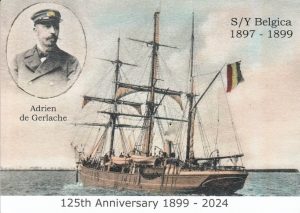 The Belgian Antarctic Expedition of 1897–1899 was the first expedition to winter in the Antarctic region. Led by Adrien de Gerlache de Gomery, it was the first Belgian Antarctic expedition and is considered the first expedition of the Heroic Age of Antarctic Exploration. Among its members were Frederick Cook and Roald Amundsen, explorers who would later attempt the respective conquests of the North and South Poles.
The Belgian Antarctic Expedition of 1897–1899 was the first expedition to winter in the Antarctic region. Led by Adrien de Gerlache de Gomery, it was the first Belgian Antarctic expedition and is considered the first expedition of the Heroic Age of Antarctic Exploration. Among its members were Frederick Cook and Roald Amundsen, explorers who would later attempt the respective conquests of the North and South Poles.
To celebrate the 125th Anniversary of the return of S/Y Belgica to Antwerp (5 november 1899) a special post card and stamps have been issued.
TNX Dr. Eddy de Busschere of the Belgian Polar Expedition Society for sending us one of this special card.
 S/Y Belgica did remain trapped in the ice for a long Antarctic winter.
S/Y Belgica did remain trapped in the ice for a long Antarctic winter.
The crew disliked the penguin and seal meat that had been stored and initially tried to ban its consumption, but Signs of scurvy began to show in some of the men. Gerlache and Captain Lecointe became so ill they wrote their wills. Two of the crew started to show signs of mental illness and morale in general was extremely poor. Lieutenant Danco fell ill from a heart condition and died on 5 June. Danco Island was named in his honor.
Cook and Amundsen took command as Gerlache and Lecointe were unable to fulfill their roles due to scurvy. The true cause of scurvy as a deficiency of Vitamin C was not discovered until the 1920s, but Cook was convinced that raw meat was a possible cure for scurvy due to his experiences with Robert Peary in the Arctic. He retrieved the frozen penguin and seal meat and insisted that each man eat some each day. Even Gerlache began to eat the meat and slowly the men recovered their health. It is now known that raw meat and organs contain a small amount of Vitamin C.
Several months of hardship followed. Even as spring and summer arrived, attempts to free the ship and its crew from the grip of the ice failed. By January 1899, Belgica was still trapped in ice about seven feet (2.1 m) thick and the possibility of another winter in the ice seemed real. Open water was visible about half a mile away and Cook suggested that trenches be cut to the open water to allow Belgica to escape the ice. The weakened crew used the explosive “tonite” and various tools to create the channel. Finally, on 15 February 1899, they managed to start slowly down the channel they had cleared during the weeks before. It took them nearly a month to cover seven miles (11 km), and on 14 March, they cleared the ice. The expedition returned to Antwerp on 5 November 1899. Though the circumstances were severe, the expedition had nevertheless managed to collect scientific data, including a full year of meteorological observations.
 Edgeworth David Fied Camp (aka Edgeworth David Base) was established as a summer camp in 1986. Located at 66°14’59” South, 100°36’12” East , in the Northen Bunger Hills, Edgeworth David summer Base lies about 7 kilometres (4.3 mi) from WNW of Polish Antoni Dobrowolski Station (WAP POL-NEW), approximately 440 km west of Casey Research Station (WAP AUS-Ø2)and 85 km inland from the Shackleton Ice Shelf in the Bunger Hills region, Wilkes Land.
Edgeworth David Fied Camp (aka Edgeworth David Base) was established as a summer camp in 1986. Located at 66°14’59” South, 100°36’12” East , in the Northen Bunger Hills, Edgeworth David summer Base lies about 7 kilometres (4.3 mi) from WNW of Polish Antoni Dobrowolski Station (WAP POL-NEW), approximately 440 km west of Casey Research Station (WAP AUS-Ø2)and 85 km inland from the Shackleton Ice Shelf in the Bunger Hills region, Wilkes Land.
Edgeworth David is a summer-only Station, a research outpost named after Sir Edgeworth David, opened in 1986 by the Australian Antarctic Division (AAD), it is temporary visited during the summer season and used for Geological, Geophysical, Geomorphological and Biological research.
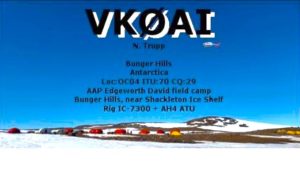 Edgeworth David Field Camp has been “On Air” on last dec. 25 & 26 2023 signing VKØAI, operated by N E “Norbert” Trupp (VK5MQ).
Edgeworth David Field Camp has been “On Air” on last dec. 25 & 26 2023 signing VKØAI, operated by N E “Norbert” Trupp (VK5MQ).
Norbert was deployed to Edgeworth David; weather delayed the return flight to Casey Station, allowing Norbert a brief period of operating on the 25th and 26th December 2023. Daytime propogation was poor and bands only opened in the evening, with all contacts FT8. Camp power is supplied by generator while operating times and satellite comminications are limited.
At the light of this evidence and a copy of QSL provided by Olivier F6EPN (Spratley Woody), we have given Edgeworth David Field Camp a reference as WAP AUS-1Ø.
The “New Refrence” will appear on next WAP-WADA and WAP-WADA Directories (Release of June 2024).
TNX Olivier F6EPN
 The twenty third edition (release 1.43) of WAP WACA & WADA Directories are available to download. From the main page of WAP website, just go to the “Download Section” and select WAP-WACA & WAP-WADA Directories and feel free to save them both on your PC.
The twenty third edition (release 1.43) of WAP WACA & WADA Directories are available to download. From the main page of WAP website, just go to the “Download Section” and select WAP-WACA & WAP-WADA Directories and feel free to save them both on your PC.
WACA Directory contains a list of more than 4362 callsigns used in Antarctica & Sub Antarctic territories since 1945.
WADA Directory lists 1005 Bases, Camps, Huts, Refuges and Stations in Antarctica since 1945.

Also a new release of the Antarctic & Peri Antarctic Lighthouses has been issued on January 1st 2024 and it’s available to download as well; just go to the Lighthouse page.
Enjoy Antarctica!
73 from WAP Staff
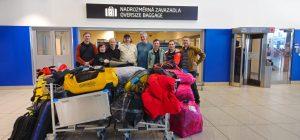 Few days ago, the Czech members of the Antarctic Expedition to Nelson Island were in Punta Arenas, Chile, waiting for a Brazilian ship to take them to their destination. That morning the host of Studio 6, expedition leader Václav Pavel, described in a live broadcast, what awaits them on Nelson Island.
Few days ago, the Czech members of the Antarctic Expedition to Nelson Island were in Punta Arenas, Chile, waiting for a Brazilian ship to take them to their destination. That morning the host of Studio 6, expedition leader Václav Pavel, described in a live broadcast, what awaits them on Nelson Island.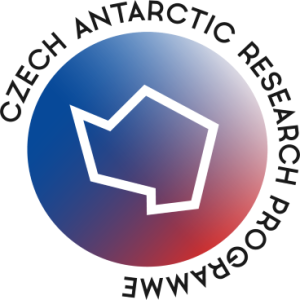
Dr. Vaška Pavel from the Czech Antarctic Foundation, remind the followers that yesterday, the Team: 8 members (1 woman and 7 men, including 3 scientists from the Faculty of Science of Masaryk University and 2 from the Ukrainian National Program) boarded the Polar Ship Ary Rongel of the Brazilian 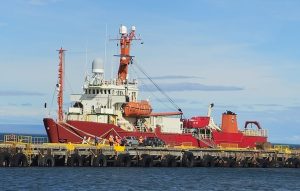 Antarctic Program, which will set sail this afternoon Jan 2nd 2024, heading Antarctica.
Antarctic Program, which will set sail this afternoon Jan 2nd 2024, heading Antarctica.
If you missed the report, from expedition leader Václav Pavel , you can watch it by clicking on the link, here below:
While wishing them the best numbers for the new year, WAP wish the Team a good trip and a good stay down there… Weare radioamateurs and our real wish is that … some days, berore too long Echo Nelson Base WAP CZE-Ø1 and Johan Gregor Mendel Station (WAP CZE-NEW) could be heard on air!
A video from Mendel Station (WAP CZE-NEW) show how is the Base … perhaps the only thing missed is a radio operator to put on Ham bands, this rare and never worked Czech Antarctic Base!

 Hi folks,
Hi folks,
for the whole 2023 we have dedicated our efforts as we have done for over 40 years. We have followed the activities of the Nations, Researchers and Personnel in Antarctica, animated by the passion that has not abandoned us until now.
With this spirit, we wish our Readers, the Radio Amateurs from all over the world who follow us and all those who love Antarctica as we love it, the best wishes for the coming up 2024 , which will certainly find us a little older but always here, turning the VFO knob.
We hope and wish the whole world a year of PEACE, that hatred between peoples ceases … we need PEACE, peace not bombs!
With best wishes from Max IK1GPG, Betty IK1QFM, Gianni I1HYW together with thousands of friends who share and help us to keep alive the love for Antarctica, a land of peace and research for the good of humanity.
Sincerely,

The Belgrano 2 Base Crew, together with the Mactrail company, did embark on the ARA Almirante Irizar Icebreaker , a shelter that will be installed 350 km from the Base in the direction of the South Pole. It will serve as a logistical support point for a future expedition.
The Huts should be two, one named “Refugio Base Antarctica Esperanza” and the second one named “Refugio Base Belgrano 2”.
New ones to look for …
 Our good friend Volker, DL8JDX is currently embarked on M/S Hamburg heading Antarctica. They will be in the Antarctic until Jan. 29, 2024… unfortunately, no radio from him!
Our good friend Volker, DL8JDX is currently embarked on M/S Hamburg heading Antarctica. They will be in the Antarctic until Jan. 29, 2024… unfortunately, no radio from him!
On the way on, Volker has already seen the stations Teniente Camara (WAP ARG-16), Gabriel de Castilla (WAP ESP-Ø2), Deception (WAP GBR-Ø2) and Almirante Brown (WAP ARG-Ø2). On the up and down cruise, the ship stopped at the Falkland Islands as well.
.
Over there, Volker had the opportunity to meet Bob, VP8LP and his wife Janet VP8AIB in Stanley, Falkland Islands; they are currently active with the special call VP8FLY from the Stanley Airport.

The outdoor shack in the picture aside, is that one at the Airport of Stanley.
.
TNX Volker DL8JDX
.
.
WAP wish the Antarctic enthusiasts and the Ham radio community all over the World, together with the personnel of Mario Zuchelli Station (WAP ITA-Ø1) and Concordia Station (WAP MNB-Ø3) a very Merry Christmas, and our great hope of PEACE and brotherhood in the world. Pics and credit #PNRA e #IPEV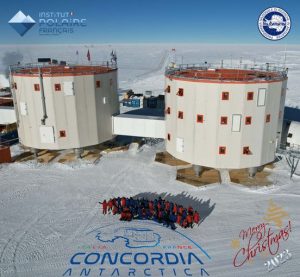

 On the cusp of the COP28 climate talks, U.N. Secretary-General Antonio Guterres visited Antarctica and stopped at Chilean Base P.te Eduardo Frei (WAP CHL-Ø5), after previously saying the world must slash carbon emissions to prevent this delicate environment from melting.
On the cusp of the COP28 climate talks, U.N. Secretary-General Antonio Guterres visited Antarctica and stopped at Chilean Base P.te Eduardo Frei (WAP CHL-Ø5), after previously saying the world must slash carbon emissions to prevent this delicate environment from melting.
Warming air and ocean temperatures are causing Antarctic ice to melt. The frozen continent plays a significant role in regulating Earth’s climate because it reflects sunlight away and drives major ocean currents.
For years, scientists and environmentalists have kept an eye on the West Antarctic Ice Sheet as an important indicator of global warming.
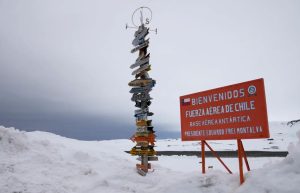 A study published in Nature Climate Change last month said warming has increased to the point that the ice sheet will now experience “unavoidable” melting regardless of how much the world reduces emissions of planet-warming gases like carbon dioxide.
A study published in Nature Climate Change last month said warming has increased to the point that the ice sheet will now experience “unavoidable” melting regardless of how much the world reduces emissions of planet-warming gases like carbon dioxide.
The study’s lead author, Kaitlin Naughten, estimated that melting ice in Antarctica’s most at-risk areas could raise global sea levels by about 1.8 meters (5.9 feet) over the next few centuries.
–
Read more at: Antarctica – latest news, breaking stories and comment
Thanks and Credit to: The Indipendent, https://www.independent.co.uk
 Ernest Krenkel was an explorer, radio operator, doctor of geographical sciences (1938), and Hero of the Soviet Union (1938). He held several Ameteur Radio callsigns: EU2EQ, U3AA, UA3AA, RAEM and RAEM/MM. Born in Balystok, Poland 24 december 1903, Ernest Kernkel passes away in Moscow, on 8 december 1971.
Ernest Krenkel was an explorer, radio operator, doctor of geographical sciences (1938), and Hero of the Soviet Union (1938). He held several Ameteur Radio callsigns: EU2EQ, U3AA, UA3AA, RAEM and RAEM/MM. Born in Balystok, Poland 24 december 1903, Ernest Kernkel passes away in Moscow, on 8 december 1971.
Krenkel was in Antarctica, in 1968, the honored scientist shook off the antiquity for the last time and led another Polar expedition to Antarctica.
Further, on February 6, 1969, on the Antarctic island of King George, where the Bellingshausen station is located, a meeting was held with the President of Chile, Eduard Frey, who visited the real one standing on this site. During the sail, Krenkel went on the air on shortwave amateur radio bands under the call sign RAEM/MM.
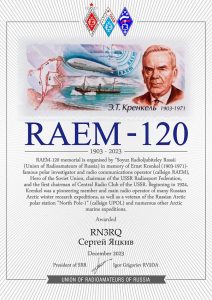 RAEM-120 Award
RAEM-120 Award
This year Russian Union of Radio Amateurs celebrates a significant date – 120 years since the birth of the outstanding polar explorer Ernst Teodorovich Krenkel (RAEM) the first Polar radio operator (RAEM). Date of this challenge is from December 15 to 25, 2023.Here below, the list of call signs that will work at the E.T. Krenkel Memorial.
R120RAEM – Novosibirsk region
R120A – Moscow city
R120D – Moscow region
R120I – Tomsk region
R120K – Arkhangelsk region
R120M – Stavropol region
R120N – Nizhny Novgorod region
R120R – Tambov region
R120S – Sverdlovsk region
R120T – Tyumen region
R120W – Irkutsk region
R120X – Samara region
Check: R120I – Callsign Lookup by QRZ Ham Radio for more info
In the book “The life of an engineer” written by, Zubkov E.V. , and on “RAEM/MM is my callsign”, WAP picked up some paragraphs to get more info about Ernest Krenkel, Arctic & Antarctic veteran explorer:
See: raem009 (antentop.org)
On November 15, 1968, R/V Professor Zubov, set off on its first Antarctic voyage, carrying 250 participants of the 14th SAE (Soviet Antarctic Expedition). The scientific-research vessel Professor Zubov was bound for the shores of Antarctica to relieve its staff of winterers found there, and also for oceanographic research. Ernest Krenkel was one of the expedition members and the ship’s crew head. Krenkel was wintering at Molodezhnaya Station where the second batch of polar explorers from the fourteenth SAE was located, heading to Mirny, Vostok and Bellingshausen.
During the voyage on the R/V Zubov, Krenkel, kept a diary. He was a gifted narrator, graphic, with apt language in which were no trite sentences or clumsy wording. Ernst Teodorovich appears before us as a very ordinary man who with boyish ardour is concerned with his daily watch on the air for radio amateurs.
In 1933, Krenkel sailed as a radio operator on the icebreaker Sibiryakov. For the first time in the history of navigation, the ship then passed the Northern Sea Route (from Murmansk to the Bering Strait) in one summer season.
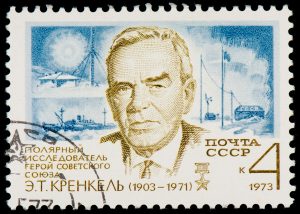 In 1934 RAEM was the callsign of the I/B Cheluskin smashed by ice in the North polar sea. I was the chief operatore –wrote krenkel- Since then RAEM is my personal amateur callsign.
In 1934 RAEM was the callsign of the I/B Cheluskin smashed by ice in the North polar sea. I was the chief operatore –wrote krenkel- Since then RAEM is my personal amateur callsign.
In 1968, Krenkel was 65 years old. On the flight he was on, he was perceived as an old man. Gray-haired, tall, gaunt, bony. People treated him with respect and not because he was the flight commander, but they sympathized with him in a purely human way. His manner was conducive to that: accessibility, restrained benevolence. A person who has spent a long time in the closed, close collectives of polar stations cannot be arrogant and inaccessible. Here aside the Soviet postage stamp dedicated to Ernst Krenkel, a Soviet Arctic explorer, doctor of geographical sciences (1938), and Hero of the Soviet Union (1938).
WAP hopes the great family of the WW Radio Amateurs will join this important HF event!
TNX DX Trophy (Oleg UA6GG)
 A celebration held at Argentinean Base San Martín (WAP ARG-Ø8) on the day of the Immaculate Conception, gathered the Base personnel to pray in front of the niche with the image of the Immaculate Virgin Mary.
A celebration held at Argentinean Base San Martín (WAP ARG-Ø8) on the day of the Immaculate Conception, gathered the Base personnel to pray in front of the niche with the image of the Immaculate Virgin Mary.
It is beautiful to see how, even in Antarctica, the desire for prayer is felt, as well as the importance of the Immaculate Virgin protection is not forgotten … these are experiences that touch the heart.
WAP joins the ceremony of that particular day and wish everyone down there a safe season in the magic white Antarctic to be enjoyed
Keep up the good work guys!
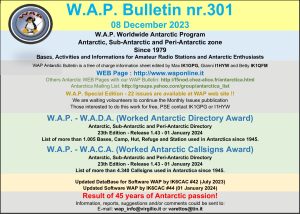 WAP Antarctic Bulletin nr. 301 relaesed today December 8th 2023 is available on line with last info and reported activity from Antarctica.
WAP Antarctic Bulletin nr. 301 relaesed today December 8th 2023 is available on line with last info and reported activity from Antarctica.
Bull 301 is downloadable at: http://www.waponline.it/wap-antarctic-bulletins/
The new graphic design of the bulletin was edited by Max IK1GPG and Betty IK1QFM and looks modern in style, easy to read with nice relate pictures of QSLs.
Enjoy hunting Antarctic Stations and if/when possible, remind the Polar Institutes in your Countries to promote Hamradio in Antarctica … as we get used in the past decades . Years ago, almost all of the Scientific sites, Bases, Camps, Huts, Polar Ships in Antarctica were active on HF.
Year after year we are loosing many wondeful opportunity to lig rare Antarctic sites. It could be that, personnel stationed in the Antarctic Bases had become a little lazy every year or that, the radio is no longer that intelligent distinctive element of connection between Antarctica and the outside world!
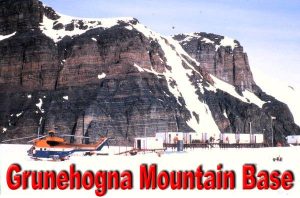 Grunehogna Mountain Base and Sarie Marais Field Base , at 72°Ø2’ØØ”South Ø2°48’ØØ”West, 1047 mts of altitude, seems to be two different Antarctic Bases but really, it’s the same site which holds two names. (pic on the Left, shows Grunehogna, while pic on the Right sows Sarie Marais).
Grunehogna Mountain Base and Sarie Marais Field Base , at 72°Ø2’ØØ”South Ø2°48’ØØ”West, 1047 mts of altitude, seems to be two different Antarctic Bases but really, it’s the same site which holds two names. (pic on the Left, shows Grunehogna, while pic on the Right sows Sarie Marais).
.
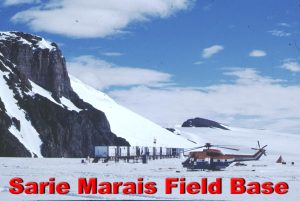 Located 250km inland from the main SANAE IV Base (WAP ZAF-Ø3), this site that bears two names, is a South Africa summer base which is used in support of Geological parties.
Located 250km inland from the main SANAE IV Base (WAP ZAF-Ø3), this site that bears two names, is a South Africa summer base which is used in support of Geological parties.
There is not much information about the Sarie Marais or Grunehogna Base on the web, but there is a NZ page Grunehogna Mountain Base, 250km inland from SANAE | Antarctica NZ and a South Africa’s page Sarie Marais Summer Station being raised (sun.ac.za) that shows a couple of pictures of this forgotten Base (which looks almost the same even if the pics are taken from different angles) listed and numbered on WAP-WADA Directory as WAP ZAF-Ø4.
 A QSL provided recently by Bob, K4MZU clearly show and documents a QSO dated 14 January 1992 with ZS5GMT Graham Tilbury who was operating ZS7ANT on 10 mts from Grunehogna Mountain Base as the operator detailed with a note on the rear side of the QSL card.
A QSL provided recently by Bob, K4MZU clearly show and documents a QSO dated 14 January 1992 with ZS5GMT Graham Tilbury who was operating ZS7ANT on 10 mts from Grunehogna Mountain Base as the operator detailed with a note on the rear side of the QSL card.
ZS5GMT, Graham Tilbury is currently resident in the US, his callsign is KK4FRD
Thanks o Bob K4MZU and to Olivier F6EPN (aka Spratley Woody) we have got some more documentation covering this Base with two names and who knows … after 30 years, maybe someone could try to activate it again … one day or another!
 Humans didn’t discover Antarctica until 1820.
Humans didn’t discover Antarctica until 1820.
Once discovered, several nations sought to claim the continent as their own. As tension increased, some countries began working on a peaceful solution.
On December 1st, 1959 in Washington, D.C. delegates from 12 Countries (Argentina, Australia, Belgium, France, Chile, Japan, New Zealand, Norway, South Africa, , Soviet Union, United Kingdom and United States), came together to sign the Antarctic Treaty which is considered to be one of the most successful achievements of the international community.
Antarctica Day , along with Midwinter Day, it is one of Antarctica’s two principal holidays.
Since then, on December 1st, Antarctica Day recognizes the anniversary of the Antarctic Treaty which established that Antarctica is and will remain a nature reserve dedicated to peace and science.
It’s also a day to learn more about this cold and barren Continent, surf the pages of WAP website and enjoy Antarctica as much as we do.
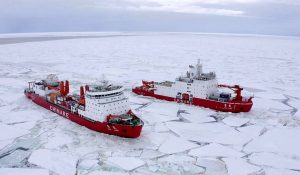 Two Chinese icebreaker research vessels and a cargo ship set sail last November 1st for the Antarctic with more than 460 personnel on board to help complete construction of China’s fifth Research Station on the world’s southernmost continent, which could be finished next year.
Two Chinese icebreaker research vessels and a cargo ship set sail last November 1st for the Antarctic with more than 460 personnel on board to help complete construction of China’s fifth Research Station on the world’s southernmost continent, which could be finished next year.
China’s biggest flotilla of research vessels deployed to the Antarctic will focus on building the station on the rocky, windswept Inexpressible Island near the Ross Sea, a deep Southern Ocean bay named after a 19th century British explorer.
Work on the first Chinese station in the Pacific sector, began in 2018. It will be used to conduct research on the region’s environment, state television reported.
The two icebreakers, Xuelong 1 and Xuelong 2, the name means “Snow Dragon” in Chinese, set sail from Shanghai with mostly personnel and logistics supplies on board.
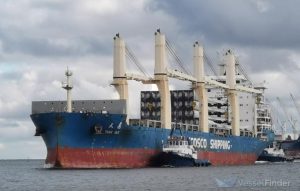 The cargo ship “Tianhui”, or “Divine Blessings”( TIAN HUI, General Cargo Ship – Details and current position – IMO 9774599 – VesselFinder) , taking construction material for the station, set off from the eastern port of Zhangjiagang.
The cargo ship “Tianhui”, or “Divine Blessings”( TIAN HUI, General Cargo Ship – Details and current position – IMO 9774599 – VesselFinder) , taking construction material for the station, set off from the eastern port of Zhangjiagang.
The five-month mission will include a survey on the impact of climate change.
The two icebreakers will also conduct environmental surveys in the Prydez Bay, the Astronaut Sea in southeast Antarctic, and in the Ross Sea and Amundsen Sea in the west.
This China’s mission to the Antarctic, will also cooperate with countries including the United States, Britain, and Russia on logistics supply, state media said.
Source: China’s Biggest Antarctic Fleet Sets Off To Build Fifth Research Station (ndtv.com)
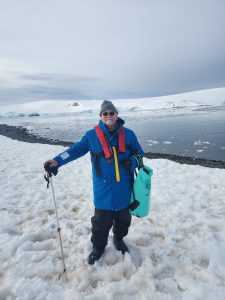 Don Conlee WX5DC is a professor at A&M Atmospheric Sciences in Texas.
Don Conlee WX5DC is a professor at A&M Atmospheric Sciences in Texas.
 Don, along with class members, is actually on board of M/V Ocean Victory sailing to the South Shetland Islands/Antarctica .
Don, along with class members, is actually on board of M/V Ocean Victory sailing to the South Shetland Islands/Antarctica .
He has sent us a message and some pics: -We finally got everything together and had a few FT8 contacts on 20m last night! We were using WX4/WX5DC. I hope that we will be able to try SSB tonight between 00Z and 03Z, ~14.243. The student on the attached pic is Katherine Forson KT5KMF.
We may 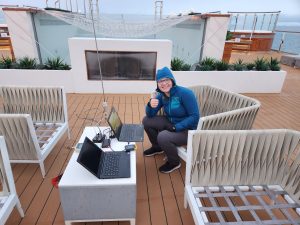 operate briefly before dinner and hopefully for the sweet spot of 0-3Z. Winds have died down and snow stopped, so fingers crossed-.
operate briefly before dinner and hopefully for the sweet spot of 0-3Z. Winds have died down and snow stopped, so fingers crossed-.
We’ll keep our ears open … hopefully we can catch Don someway!
Trace the ship voyage at: Ship OCEAN VICTORY (Passenger Ship) Registered in Bahamas – Vessel details, Current position and Voyage information – IMO 9868869, MMSI 311000868, Call Sign C6ED9 | AIS Marine Traffic
.
TNX Don WX5DC & Katherine KT5KMF
 February 2024 marks the 21st edition of the Antarctic Activity Week (AAW) launched by WAP (Worldwide Antarctic Program). The 2024 edition will last from Febr. 18 till Feb.25.
February 2024 marks the 21st edition of the Antarctic Activity Week (AAW) launched by WAP (Worldwide Antarctic Program). The 2024 edition will last from Febr. 18 till Feb.25.
Invitation, is addressed to all Radio Amateurs (OMs & SWLs) around the world, to the Clubs and Organizations as well as other important groups, Radio Clubs and individual operators who would like to join and share with us, this initiative.
Hams can use Special Prefixes recalling Antarctica as for example II6ANT, IR8ANT, IR2ANT, TM…ANT, DL…ANT, UA…South Pole, ZX…ANT, KK…ANT, VK….AAW, VX…WAP and so on. No rules have been made but all the special Prefix will be given a related WAP-reference number which can be used to achieve the WAP Awards.
Nobody will have to give progressive numbers, nothing at all, just working and log, as DX stile. In other words, any kind of Special Prefixes recalling Antarctica someway can join the event.
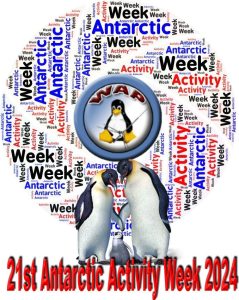 As known, the main purpose of the A.A.W. is to increase worldwide interest around Antarctic Continent and its related matters, with the aim of staying close to the researchers and personnel who are spending their time away from home and families, studying the Antarctic life and its secrets. Additional purpose is to share what Nations and Organizations are doing to protect this still non contaminated corner of the world, to share a message of peace WW.
As known, the main purpose of the A.A.W. is to increase worldwide interest around Antarctic Continent and its related matters, with the aim of staying close to the researchers and personnel who are spending their time away from home and families, studying the Antarctic life and its secrets. Additional purpose is to share what Nations and Organizations are doing to protect this still non contaminated corner of the world, to share a message of peace WW.
Again our intention is to draw the attention to the Antarctic Continent; AAW is the unique event WW where Hams wish to celebrate and improve Worldwide interest around it.
To any new Special Callsign joining the AAW will be given a related WAP Reference number, while the stations that have participated in previous years, can use the WAP reference already assigned.
Check the AAW page, http://www.waponline.it/antarctic-activity-week/aaw-2024/ to get informed … Join the event and enjoy it!
All stations will qualify for WAP awards: http://www.waponline.it/wap-awards/. Just surf the WAP website to get all the information eventually needed.
 The Captain Pieter J. Lenie Base (WAP USA-12) is an Antarctic summer base operated by the United States located at Copacabana Beach, Admiralty Bay (King George Island). About two kilometers northwest of this base, is the Polish Research Station Arctowski (WAP POL-Ø1).
The Captain Pieter J. Lenie Base (WAP USA-12) is an Antarctic summer base operated by the United States located at Copacabana Beach, Admiralty Bay (King George Island). About two kilometers northwest of this base, is the Polish Research Station Arctowski (WAP POL-Ø1).
Pieter J. Lenie Base, also known as Copa (short for Copacabana), consists of three small buildings at the foot of Rescuers Hills, near Liano Point. The field station is located at 62° 10′ South, 58° 28′ West at Antarctic Special Protected Area (ASPA) 128. It was originally set up in 1978 as a refuge Hut, and was substantially upgraded and formally named for Pieter J. Lenie (captain of the American Antarctic research ship R/V Hero) in 1985.
Originally established for the long-term study of Pygoscelis penguins that nest nearby. Scientific research done at the Base is focused on population and diet monitoring of the Adèlie penguin and Gentoo penguin colonies on the beach, as well as second-hand monitoring of Krill populations in the adjacent waters
Pieter J. Lenie Base is a real rare one fot many Antarctic chasers… who knows … maybe, shortly someone from the Polish Arctowski Station, could be there and activate it … let’s keep our finger crossed!
 The new building of the Henryk Arctowski Polish Antarctic Station, will become operational in 2023. Two years earlier, as part of the tests, the structure will be assembled in Poland
The new building of the Henryk Arctowski Polish Antarctic Station, will become operational in 2023. Two years earlier, as part of the tests, the structure will be assembled in Poland
«If everything goes according to plan, scientists will start using the new building in 2023» says Deputy Administrative Director at the Institute of Biochemistry and Biophysics PAS, Agnieszka Kruszewska, who add: « The station is a facility of this institution»
Henryk Arctowski Polish Antarctic Station (WAP POL-Ø1) located at 62°09’45” South, 58°27’45” West is one of about 40 all-year stations in that part of the world. It is located in the southern hemisphere, in the South Shetland archipelago, on King George Island.
It started operating in 1977. When the main building of the station was originally built, it was several meters from the sea; now, at high water levels, that distance is less than a meter and for this reason the building is threatened with destruction. In addition, the outdated infrastructure of the station is worn out after many years of use in polar conditions. That is why for several years scientists have been seeking funds for the new building and its facilities.
The design of the new station was prepared in 2015 by Kuryłowicz & Associates. In November 2018, the 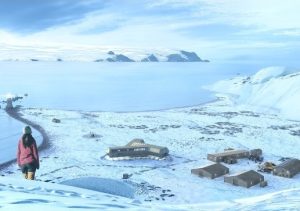 Ministry of Science announced that it would provide a designated purpose to modernize the station`s infrastructure and build a new main building. Its layout will resemble a three-pointed star. In the heart of the station there will be a common space where residents will spend time.
Ministry of Science announced that it would provide a designated purpose to modernize the station`s infrastructure and build a new main building. Its layout will resemble a three-pointed star. In the heart of the station there will be a common space where residents will spend time.
The new main building of the station will accommodate up to 40 people who will be able to stay there all year. She adds that the working, living and technical service conditions will certainly improve.
The new building will be located 100 meters from the shoreline, on a stable surface. Geological analyses were carried out before choosing the location.
Read more at: The new Polish Antarctic station will become operational in 2023 | Science in Poland
 The Islas Malvinas Refuge, originally Antonio Moro, is an Antarctic Refuge located at 200 m a.s.l. at 63°25′ South, 56°58′ West, at Nunatak Nobby, Tabarin Peninsula, Bahía Esperanza .
The Islas Malvinas Refuge, originally Antonio Moro, is an Antarctic Refuge located at 200 m a.s.l. at 63°25′ South, 56°58′ West, at Nunatak Nobby, Tabarin Peninsula, Bahía Esperanza .
It was inaugurated on August 20, 1955. It’s a metal cabin 2 m x 2 m x 2 m x 3 m with provisions for 4 people for 15 days’ worth of food, fuel, gas and a first aid kit.
The original name of the shelter was a tribute to Antonio Moro (1906-1979), an italian immigrant who participated in the founding of San Martin Base (WAP ARG-Ø8) in 1951 and who built shelters in the area of the Esperanza Base (WAP ARG-Ø4) in 1954, including the one that would bear his name. It was renamed to its current name Refugio Islas Malvinas on 26 August 1971 and rebuilt in 1988.
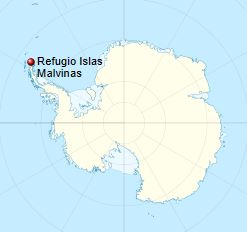 Refugio Islas Malvinas (WAP ARG-New) is one of the 18 shelters that are under the responsibility of the Esperanza base, which is responsible for maintenance and care. It is administered by the Argentine Army.
Refugio Islas Malvinas (WAP ARG-New) is one of the 18 shelters that are under the responsibility of the Esperanza base, which is responsible for maintenance and care. It is administered by the Argentine Army.
The shelter square is located on a rocky promontory. From there there are views of the nearby Buenos Aires Glacier (used for small plane descents), Mount Flora, and the Weddell Sea. In 1986 it was proposed that small contingents of tourists visit the refuge from the Esperanza Base.
WAP hopes that some days Refugio Islas Malvinas (WAP ARG-New) will be shown up on the air … it’s a shame to know that it is visited regularly and nobody thinks to activate it on HF.
TNX Gabry IK1NEG
 While waiting two years and three months to be rescued when their sloop Favorite was shipwrecked at Kerguelen in 1825, the British sealer and cartographer John Nunn and his crew spent some miserable months trying to survive on Saddle Island (now called Ile de l’Ouest) at 49°17’59” South, 70°31’56” East, buffeted by the merciless westerly winds.
While waiting two years and three months to be rescued when their sloop Favorite was shipwrecked at Kerguelen in 1825, the British sealer and cartographer John Nunn and his crew spent some miserable months trying to survive on Saddle Island (now called Ile de l’Ouest) at 49°17’59” South, 70°31’56” East, buffeted by the merciless westerly winds.
Nunn concluded that there was a better chance of being discovered on the southeastern part of Grande Terre, the main island, so his group gradually skirted the southern coast in search of a place to settle in. (Image above is extracted from page 148 of Narrative of the Wreck of the “Favourite” on the Island of Desolation: detailing the adventures, sufferings and privations of J. Nunn, an historical account of the Island, and its whale and seal fisheries, by NUNN, John. Original held and digitised by the British Library. )
After passing Shoal water Bay (now called Baie Norvégienne), they were eventually able to find an area suitable for monitoring passing ships at Long Point (now called Pointe Charlotte) on the East coast of Courbet Peninsula, where they built two comfortable cabins which they baptized Hope Cottage.
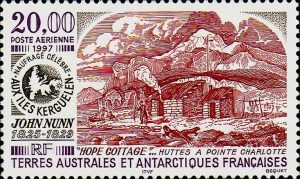 The group was finally spotted in 1827 by Captain Alexander Distant on the schooner Sprightly, belonging to the celebrated shipowner Enderby of London. Nunn and his crewmates joined the Sprightly in hunting whales and elephant seals until 25 March 1829, at which point they were finally returned to Harwich, England four years after the shipwreck.
The group was finally spotted in 1827 by Captain Alexander Distant on the schooner Sprightly, belonging to the celebrated shipowner Enderby of London. Nunn and his crewmates joined the Sprightly in hunting whales and elephant seals until 25 March 1829, at which point they were finally returned to Harwich, England four years after the shipwreck.
In 1997, the French post office issued a 20-franc air mail stamp to commemorate the shipwrecks and the construction of Hope Cottage.
Thanks and credit: Kerguelen Islands, French Southern and Antarctic Lands (Part 1) – Iles Kerguelen, TAAF (discoverfrance.net)
Next Sunday, october 29, LU4ZS will be on air from 2 pm to 10 pm utc on 10, 20 and 40 meters SSB.
A commemorative digital QSL will be issued for this event .
 October 29, marks the fifty-fourth anniversary (1969-2023) of the birthday of Marambio Joint Antarctic Base (WAP ARG-21). The Base owes its name to Gustavo Argentino Marambio, pioneer of Argentine aviation over the Antarctic sector. It was founded on October 29, 1969, and remains active throughout the year with a permanent population.
October 29, marks the fifty-fourth anniversary (1969-2023) of the birthday of Marambio Joint Antarctic Base (WAP ARG-21). The Base owes its name to Gustavo Argentino Marambio, pioneer of Argentine aviation over the Antarctic sector. It was founded on October 29, 1969, and remains active throughout the year with a permanent population.
For this reason, the Marambio Base station LU4ZS, on the same Sunday, will put on the air a commemorative digital QSL that can be accessed by Argentine and foreign radio amateurs as well as SWL listeners from around the world.
The operation will be in SSB between 14:00 and 22:00 UTC on the 10, 20 and 40 meter bands, Contact information can be sent using the LU4ZS page on QRZ.com. A commemorative digital QSL onfirmation will be given in retourn.
Marambio Joint Antarctic Base (WAP ARG-21) is the main scientific station with permanent Argentine military support. The Base is under the Joint Antarctic Command and is located on Seymour Island (aka Marambio Island) on the Weddell Sea at 64°14′ South, 56°38′ West, within the sector claimed by Argentina under the name of Antarctica Argentina.
TNX Carlos LU7DSY
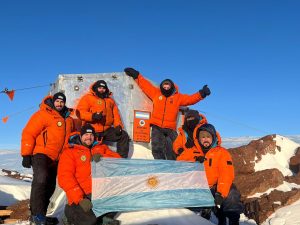 Last mid september 2023, a patrol from the Joint Antarctic Base Belgrano II (WAP ARG-Ø6) carried out a reconnaissance of the march route between the Belgrano 2 Base and the Sargento Roque Cisterna Refuge in the Little Wood Nunatak at 77°52’ South, 24°19’ West.
Last mid september 2023, a patrol from the Joint Antarctic Base Belgrano II (WAP ARG-Ø6) carried out a reconnaissance of the march route between the Belgrano 2 Base and the Sargento Roque Cisterna Refuge in the Little Wood Nunatak at 77°52’ South, 24°19’ West.
Once there, the group of Argentine Antarcticians have worked to install a VHF repeater. Argentines use a number of Refuges and Huts that serve a similar purpose to mountain refuges. They keep provisions in them constantly, repair them, and when the need arises for scientific research, small groups go to them and get to work. It is a very economical and valuable plan, and it’s another indication of the splendid work that the Argentines do in Antarctica.
In general, these small buildings are wooden cabins with food, beds, fuel (gas and naphtha), dog food, bathrooms and first aid kit.
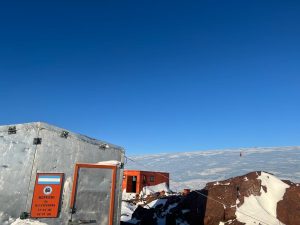 Dependent on the Belgrano II Base (WAP ARG-Ø6) Refuge Sargento Roque Cisterna (WAP ARG-NEW) has been repaired in the 2016-2017 campaign and it was also part of the inspection plan 2021-2022
Dependent on the Belgrano II Base (WAP ARG-Ø6) Refuge Sargento Roque Cisterna (WAP ARG-NEW) has been repaired in the 2016-2017 campaign and it was also part of the inspection plan 2021-2022
WAP hopes the next time another patrol going to visit the Refuge down there, a radio operator could join together! It would be very nice to put in our Hamradio log a QSO from this brand “New One” Refuge .
Worldwide Ham radio are passionate about Antarctica. Having a chance to work a New Antarctic Refuge, will be a priceless experience!
.
Thanks to: Comando Conjunto Antartico (COCOANTAR) Argentina
 Antarctica, this remote and mysterious Continent, arouses the curiosity of many people. If you’ve ever considered working there, you’ve probably wondered what the pay is for working in Antarctica. What follows, highlight the different job opportunities on this Continent. To give a more accurate idea of salaries in Antarctica, here are some examples of compensation for different types of jobs:
Antarctica, this remote and mysterious Continent, arouses the curiosity of many people. If you’ve ever considered working there, you’ve probably wondered what the pay is for working in Antarctica. What follows, highlight the different job opportunities on this Continent. To give a more accurate idea of salaries in Antarctica, here are some examples of compensation for different types of jobs:
Scientists & Researchers
Scientists can earn between €40,000 and €120,000 per year, depending on their area of research and level of expertise. Entry-level researchers or PhD students can expect a lower salary than senior researchers.
Technical & Logistics Staff
The salary for technical and logistics jobs in Antarctica usually ranges between €30,000 and €80,000 per year. Engineers, for example, can earn between €50,000 and €70,000 per year, while a mechanic or electrician can earn an annual salary of between €35,000 and €60,000.
Restaurant Jobs
Catering staff can expect an annual salary of between €20,000 and €45,000 in Antarctica. An experienced cook can earn up to €40,000 per year, while a waiter can earn a lower salary, around €25,000 per year.
 To find job openings in Antarctica, it is recommended to check the websites of the organizations that run research bases on the continent. These organizations include:
To find job openings in Antarctica, it is recommended to check the websites of the organizations that run research bases on the continent. These organizations include:
It is also possible to find job offers from private companies that specialize in organizing trips and expeditions to Antarctica.
Read more at: Working in Antarctica: the salary on the ice continent – French Polar Team (french-polar-team.fr)
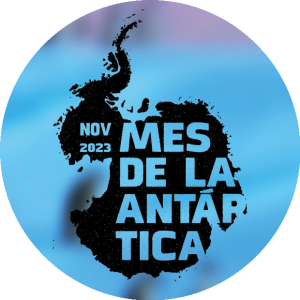 The Chilean Antarctic Institute (INACH) invites public and private institutions, organizations, research centers, educational establishments, among other entities, to serve as ambassadors of Antarctic knowledge, promoting the celebration of “Antarctica Month 2023” in their communities. around November 6, Chilean Antarctic Day.
The Chilean Antarctic Institute (INACH) invites public and private institutions, organizations, research centers, educational establishments, among other entities, to serve as ambassadors of Antarctic knowledge, promoting the celebration of “Antarctica Month 2023” in their communities. around November 6, Chilean Antarctic Day.
In this very special framework, INACH invites everyone to generate activities to spread the knowledge and appreciation of Antarctica everywhere. Knowing is the first step to appreciate and protect.
INACH wants to generate a synergy that allows to make visible the work of those who are bringing the White Continent closer to the citizens. To be part of the Antarctic Month program, INACH asks whose wishing to join, to complete the web form available at: https://forms.gle/fQYszAYG3tcjN82B7 . The maximum deadline is October 26 of this year.
This program of activities will be scattered on all platforms of the Chilean Antarctic Institute and on social media.
TNX INACH (Instituto Antarctico Chileno)
The first historic activation from the facilities of LRA 36 Radio National “Arcangel San Gabriel” at the Esperanza Antarctic Base (WAP ARG-Ø4) began on Monday, October 9th, with the Special Call L36Z.
 Amateur Radio activities,will be carried out with the purpose of contribute to spreading the presence and operation of the only Antarcticbroadcasting radio station.
Amateur Radio activities,will be carried out with the purpose of contribute to spreading the presence and operation of the only Antarcticbroadcasting radio station.
The operation is in charge of Prof. Juan C. Benavente, LU8DBS (LU8DBS/Z), who is located at Esperanza Base, coordinating the renovation and improvement tasks of LRA36, also operator of LU1ZV and now, with the special prefix L36Z, mostly 20 and 40 meters bands, SSB and FT8. QSL through LoTW, QRZ.COM. (pic aside)
The activation of L36Z is sponsored by the Radio Argentina Abroad Service (RAE), the “Uniendo Voces” project of the National University of Quilmes (UNQ), and has the special collaboration of the Radio Club Grupo DX Bahía Blanca, LU3DXG.
 LRA 36, Radio National “Arcángel Sas Gabriel”, is located at 63º 23′ South and 56º 59′ West, in the “Sargento Cabral” blockhouse at Esperanza Base, to the northern end of the Antarctic Peninsula. In front of the bay is the Antarctic Strait, and the Base is at the foot of Mount Flora, an important paleontological site. It is the only shortwave station that Argentina has in Antarctica, and transmits 15,476 KHz. Since this year, transmissions cover 12 months.
LRA 36, Radio National “Arcángel Sas Gabriel”, is located at 63º 23′ South and 56º 59′ West, in the “Sargento Cabral” blockhouse at Esperanza Base, to the northern end of the Antarctic Peninsula. In front of the bay is the Antarctic Strait, and the Base is at the foot of Mount Flora, an important paleontological site. It is the only shortwave station that Argentina has in Antarctica, and transmits 15,476 KHz. Since this year, transmissions cover 12 months.
LRA 36 went on the air for the first time on October 20, 1979: at that time on 6,030 KHz, belonging to the Radio Nacional network, linked to the Radio Argentina Exterior service (RAE), whose director is Adrián Korol, LU1CQM.
Another milestone was the first Argentine Antarctic Radio Bulletin (RANTAR), which has been broadcast on LRA 36 and on Radio Amateur bands, since March 2023.
TNX Carlos Almirón LU7DSY
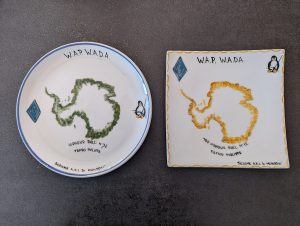 Congrats to Philippe Laurent F6FHO for the Top HR WAP WACA and WAP-WADA ceramic plates just issued.
Congrats to Philippe Laurent F6FHO for the Top HR WAP WACA and WAP-WADA ceramic plates just issued.
It’s a sign of years of continue Antarctic hunting and we know how much passion (and loss of sleep…) is necessary to achieve such a prestogious aknowledgement!
These are handcrafted ceramic plates made by a local artisan workshop in the city of Mondovì (Italy).
WAP is happy to recognize the great goal, to the DXers who, after years of intense activity and search for rare stations on the Antarctic continent, can boast such prestigious results.
To Philippe F6FHO our best wish to continue his great DX hunting